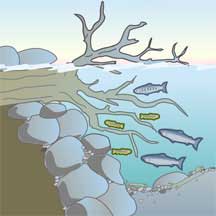Large Woody Debris as an Ecological Function
What is large woody debris?
Why is large woody debris important?
Wood helps stabilize shorelines and provides vital habitat for salmon and other creatures. Preserving and even increasing the amounts of large woody debris along shorelines is important for keeping our aquatic areas healthy and improving the survival of native salmon and other animals in King County.
Some key benefits of large woody debris to fish and other aquatic creatures:
- It provides refuge for juvenile and adult fish at a wide range of river flows, such as flood events.
- It creates pools for juvenile fish and hydraulic complexity and roughness along the river bank
- It provides food sources and habitat for aquatic insects and wildlife along shorelines.
- It helps stabilize shorelines and reduce excessive erosion.
How does large woody debris form?
Large woody debris is delivered to aquatic ecosystems in three main ways:
- Windthrow (when wood is blown down in large wind events, such as storms);
- Shoreline bank erosion;
- and mass wasting, such as landslides.
What interferes with the accumulation and placement of large woody debris?
- Shoreline armoring can keep LWD from reaching shorelines or may prevent it from lodging in one place;
- Reduced water flow (through diversions or withdrawals);
- Removal of shoreline vegetation, especially on unstable slopes, can prevent the delivery of wood to shorelines;
- In some cases, large woody debris is removed when it poses a safety concern in areas of high recreation such as boat launches.
Shoreline videos: Life on the Edge
Related information
- Large wood in King County rivers
- Flooding services and information
- Biodiversity in King County, Washington
- Water and land services

 Translate
Translate
